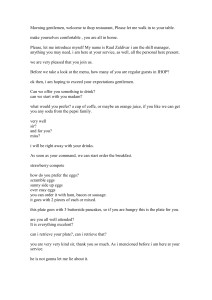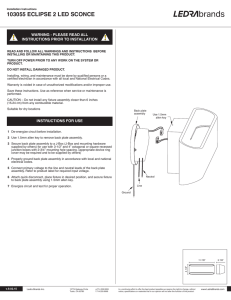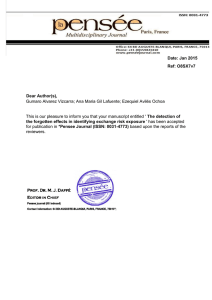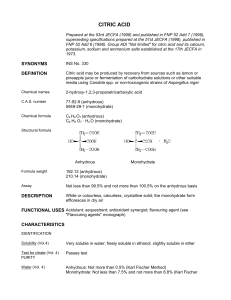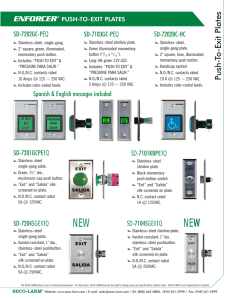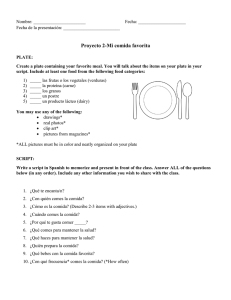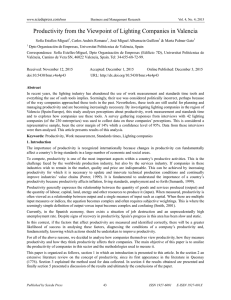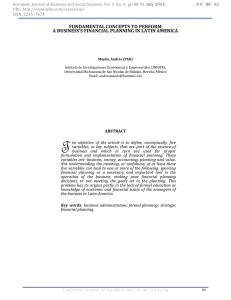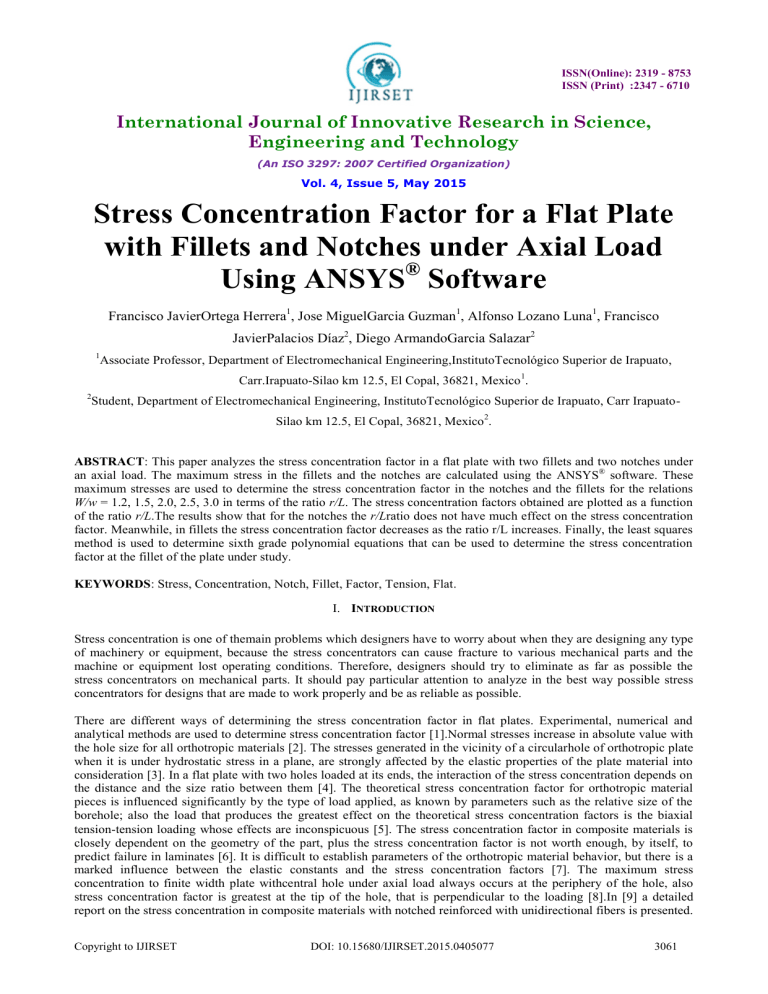
ISSN(Online): 2319 - 8753 ISSN (Print) :2347 - 6710 International Journal of Innovative Research in Science, Engineering and Technology (An ISO 3297: 2007 Certified Organization) Vol. 4, Issue 5, May 2015 Stress Concentration Factor for a Flat Plate with Fillets and Notches under Axial Load Using ANSYS® Software Francisco JavierOrtega Herrera1, Jose MiguelGarcia Guzman1, Alfonso Lozano Luna1, Francisco JavierPalacios Díaz2, Diego ArmandoGarcia Salazar2 1 Associate Professor, Department of Electromechanical Engineering,InstitutoTecnológico Superior de Irapuato, Carr.Irapuato-Silao km 12.5, El Copal, 36821, Mexico 1. 2 Student, Department of Electromechanical Engineering, InstitutoTecnológico Superior de Irapuato, Carr IrapuatoSilao km 12.5, El Copal, 36821, Mexico 2. ABSTRACT: This paper analyzes the stress concentration factor in a flat plate with two fillets and two notches under an axial load. The maximum stress in the fillets and the notches are calculated using the ANSYS® software. These maximum stresses are used to determine the stress concentration factor in the notches and the fillets for the relations W/w = 1.2, 1.5, 2.0, 2.5, 3.0 in terms of the ratio r/L. The stress concentration factors obtained are plotted as a function of the ratio r/L.The results show that for the notches the r/Lratio does not have much effect on the stress concentration factor. Meanwhile, in fillets the stress concentration factor decreases as the ratio r/L increases. Finally, the least squares method is used to determine sixth grade polynomial equations that can be used to determine the stress concentration factor at the fillet of the plate under study. KEYWORDS: Stress, Concentration, Notch, Fillet, Factor, Tension, Flat. I. INTRODUCTION Stress concentration is one of themain problems which designers have to worry about when they are designing any type of machinery or equipment, because the stress concentrators can cause fracture to various mechanical parts and the machine or equipment lost operating conditions. Therefore, designers should try to eliminate as far as possible the stress concentrators on mechanical parts. It should pay particular attention to analyze in the best way possible stress concentrators for designs that are made to work properly and be as reliable as possible. There are different ways of determining the stress concentration factor in flat plates. Experimental, numerical and analytical methods are used to determine stress concentration factor [1].Normal stresses increase in absolute value with the hole size for all orthotropic materials [2]. The stresses generated in the vicinity of a circularhole of orthotropic plate when it is under hydrostatic stress in a plane, are strongly affected by the elastic properties of the plate material into consideration [3]. In a flat plate with two holes loaded at its ends, the interaction of the stress concentration depends on the distance and the size ratio between them [4]. The theoretical stress concentration factor for orthotropic material pieces is influenced significantly by the type of load applied, as known by parameters such as the relative size of the borehole; also the load that produces the greatest effect on the theoretical stress concentration factors is the biaxial tension-tension loading whose effects are inconspicuous [5]. The stress concentration factor in composite materials is closely dependent on the geometry of the part, plus the stress concentration factor is not worth enough, by itself, to predict failure in laminates [6]. It is difficult to establish parameters of the orthotropic material behavior, but there is a marked influence between the elastic constants and the stress concentration factors [7]. The maximum stress concentration to finite width plate withcentral hole under axial load always occurs at the periphery of the hole, also stress concentration factor is greatest at the tip of the hole, that is perpendicular to the loading [8].In [9] a detailed report on the stress concentration in composite materials with notched reinforced with unidirectional fibers is presented. Copyright to IJIRSET DOI: 10.15680/IJIRSET.2015.0405077 3061 ISSN(Online): 2319 - 8753 ISSN (Print) :2347 - 6710 International Journal of Innovative Research in Science, Engineering and Technology (An ISO 3297: 2007 Certified Organization) Vol. 4, Issue 5, May 2015 The authors comment that due to the formation of the longitudinal division at the tips notch along the fiber direction, the extremely high stress concentrations ahead of the tip of notch could be reduced drastically for composites under remote tension.In [10] away optimization approach is presented to minimize stress concentration and the peaks caused by the contact pressure.In [11] the stress concentration factor in holes on orthotropic laminated plates produced by countersunk rivets under uniaxial tension load is studied, the analysis is performed using the finite element software Ansys. For his part in [12] how to get the curves of stress concentration using the ANSYS ® software is shown, the stress concentration factors are plotted in dimensionless form, obtaining curves of stress concentration factor. The stress concentration on flat plates with circular, triangular and rectangular holes is studied in [13].The concentration of stresses in a plate of infinite length with two holes of equal radii is analyzed using finite element software for analyzing the distance between the centers of the two holes and the diameter of these is varied [14]. In [15] a review of research on stress analysis in infinite plates with cuts occurs. In [16] the stress concentration on a flat plate of constant thickness with stress at its ends is analyzed, making a comparison of the results obtained by the theory of elasticity, experimentally and the method of finite elements.Stress concentration is one of the factors contributing to reduce the life of a component subjected to mechanical fatigue [17]. Using modified elliptical notches because it causes less stress concentration in comparison with semicircular notches and grooves, the ratio of the minor and major axes of the ellipse should be between 0.3 and 0.4 is suggested [18]. The elliptical opening leads to a generalized analysis, when the ratio of the minor to major axis of the ellipse axis is large, the hole tends to be a very thin slot, so their stress concentrator increases [19]. The stress concentration factor for U notches which support mixed loads is studied in [20], the authors use the criterion based on the deformation of the average energy density concept.The maximum stress concentration factors in a small rectangular hole rounded edges of orthotropic plate is located on the main axis 1 which is at 67.5º angle about the x axis [21].In [22] a flat plate with a hole in the centerunder the influence of a gradient of linear load was studied, the authors establish an approximate computational model that reduces the required type of load and support the results obtained experimentally and numerically by photoelasticity using the ANSYS® software. Stress concentration in a round bar with a circular arc or V-shaped notch with bending load, tensile load and torsional load is analyzed in [23]. A study to optimize the shape of the fillets and reduce the stress concentration in flat and round bars subjected to axial load, bending load, torsion load or combined loads is performed in [24]. The objective of this paper is to analyze the stress concentrationon a flat plate with two fillets and two notches, the plate is subjected to axial tensile load. A total of 101 simulations are performed in a finite element software in order to find the maximum stress that supports the plate and then determining the stress concentration factor, the results are plotted for the relations of W/w (greater width of the plate / lower width of the plate) of 1.2, 1.5, 2, 2.5 and 3 depending on the ratio r/L (radius the fillets/distance between the fillet and notch), finally to the values obtained were applying the least squares method to obtain equations to predict the stress concentration factor on the fillets for the study case. II. FINITE ELEMENT The study case, consisting of analyzing the concentration of stress on a flat plate with two fillets and two notches. The plate supports an axial tensile load. Finite element software ANSYS® is used for modeling parts. In this software a square eight nodes element is used for the analysis, four nodes correspond to each of the corners of the square and the other four nodes are intermediate nodes. The appropriate element for this analysis is therefore the solid 8 node 183. Figure 1 shows a schematic of eight nodes quadrilateral element. Figure 1: Eight-node quadrilateral element Copyright to IJIRSET DOI: 10.15680/IJIRSET.2015.0405077 3062 ISSN(Online): 2319 - 8753 ISSN (Print) :2347 - 6710 International Journal of Innovative Research in Science, Engineering and Technology (An ISO 3297: 2007 Certified Organization) Vol. 4, Issue 5, May 2015 Equations (1) to (8) are the shape functions of the nodes of the element shown in Figure 1 in terms of the local coordinates. Equations (9) and (10) are the partial derivatives of functions with respect to global coordinates.The Jacobian (J) is defined by Equation (11). 1 1 1 1 4 1 N j 1 1 1 4 1 N k 1 1 1 4 1 N l 1 1 1 4 1 N m 1 2 1 2 1 N n 1 1 2 2 1 N o 1 2 1 2 1 N p 1 1 2 2 N i... p 1 y N i ... p y N i ... p x J Ni... p 1 x Ni... p x Ni ... p y J x y x y J Ni (1) (2) (3) (4) (5) (6) (7) (8) (9) (10) (11) Deformation matrix is defined by Equation (12), while the shape function matrix by Equation (13) is defined. N i x B 0 N i x Ni N 0 0 N i x N i x N j 0 ... x N j 0 N j x N j x x N p x ... 0 ... N p x 0 Nj 0 ... Np Ni 0 Nj ... 0 N p x N p x 0 N p 0 (12) (13) To determine the stiffness matrix of the Gauss-Legendre quadrature is used. The stiffness matrix of each element is defined by Equation (14). e e K e K11e K12e K 21 K 22 (14) where K11e tH12 J 1 ,1 BT 1 ,1 DB 1 ,1 Copyright to IJIRSET (15) DOI: 10.15680/IJIRSET.2015.0405077 3063 ISSN(Online): 2319 - 8753 ISSN (Print) :2347 - 6710 International Journal of Innovative Research in Science, Engineering and Technology (An ISO 3297: 2007 Certified Organization) Vol. 4, Issue 5, May 2015 K12e tH1 H 2 J 1 ,2 BT 1 ,2 DB 1 ,2 (16) K tH 2 H1 J 2 ,1 B 2 ,1 DB 2 ,1 (17) K tH J 2 ,2 B 2 ,2 DB 2 ,2 (18) e 21 e 22 T 2 2 T Equations (1) to (18) define a square element with eight nodes. III. METHODOLOGY In the case study analyzed, an isotropic material is used for simulations, to this material are assigned the properties of low carbon steel, elastic modulus of 210 GPa, Poisson's ratio of 0.28. Figure2 shows the flat plate with two fillets and two notches under study, this plate has the following characteristics: Plate Length (s) of 0.6 m Applied force (F) of 100 kN Plate thickness of 0.01 m Separation between the fillet and the notch (L) of 0.05 m Notch radius (r2) of 0.005 The greater width of the plate (W), the lower width of the plate (w) and the radius of the fillets are variable and change in each analysis. Figure 2:Flat Plate with two fillets and two notches The methodology used to solve the case of proposed study is to model the platein the ANSYS® software. In this software is simulated the platebehavior, obtaining the maximum stress in the notch and the fillet. The model is performed using an element 8 Solid node 183. This element is used because it is a quadrilateral with intermediate nodes on the edges, so it tends to deform and easily attached during the meshing in a curved section. This element is configured to work as an element in plane stress with thickness. Figure 3 shows an image of one of the models created. Figure 3: Model created to solve the case study A total of 101 simulations are performed to obtain the maximum stress (σmax) in the fillets and notches. Maximum stress is then used to determine the value of the stress concentration factor (Kt). Simulations are distributed as follows: 13 simulations for the case W/w = 3 17 simulations for the case W/w = 2.5 25 simulations for the case W/w = 2.0 25 simulations for the case W/w = 1.5 21 simulations for the case W/w = 1.2 Copyright to IJIRSET DOI: 10.15680/IJIRSET.2015.0405077 3064 ISSN(Online): 2319 - 8753 ISSN (Print) :2347 - 6710 International Journal of Innovative Research in Science, Engineering and Technology (An ISO 3297: 2007 Certified Organization) Vol. 4, Issue 5, May 2015 The simulations are performed for a constant value the length (L) at a value of 0.05 m and the radius of the notches is kept constant at a value of 0.005 m.Meanwhile, for the relationship W/w = 3.0 W = 0.15 and w = 0.05 for the ratio W/w= 2.5 W = 0.125 w = 0.05 for the ratio W/w = 2.0 W = 0.1 w = 0.05 for the ratio W/w = 1.5 W = 0.075 w = 0.05 for the ratio W/w = 1.2 W = 0.06 and w = 0.05. The fillets radius (r) has the values shown in Table 1. Table 1: Values of the radius of the fillet to the realization of simulations r (m) 0.0002 0.0004 0.0006 0.0008 0.0010 0.0014 0.0016 0.0020 0.0022 W/w=3 r (m) 0.0024 0.0026 0.0030 0.0034 0.0036 0.0038 0.0040 0.0042 0.0044 r (m) 0.0046 0.0048 0.0050 r (m) 0.0005 0.0010 0.0015 0.0020 0.0025 0.0030 0.0035 0.0040 0.0045 W/w=2.5 r (m) 0.0050 0.0055 0.0060 0.0065 0.0070 0.0075 0.0080 0.0085 0.0090 r (m) 0.0095 0.0100 0.0105 0.0110 0.0115 0.0120 0.0125 r (m) 0.001 0.002 0.003 0.004 0.005 0.006 0.007 0.008 0.009 W/w=2.0 r (m) 0.010 0.011 0.012 0.013 0.014 0.015 0.016 0.017 0.018 r (m) 0.019 0.020 0.021 0.022 0.023 0.024 0.025 W/w=1.5 r (m) r (m) 0.0015 0.0150 0.0030 0.0165 0.0045 0.0180 0.0060 0.0195 0.0075 0.0210 0.0090 0.0225 0.0105 0.0240 0.0120 0.0255 0.0135 W/w=1.2 r (m) r (m) 0.002 0.020 0.004 0.022 0.006 0.024 0.008 0.026 0.010 0.012 0.014 0.016 0.018 Kt value is obtained by dividing the maximum stress (σmax) between the theoretical stress (σt), as shown in Equation (19).The stress σt is given by Equation (20); in this equation the area (A) value is calculated in the location of the notches to determine the stress concentration factor of the notches and the location of the fillets to determine stress concentration factor on the fillets. Kt max t t F A (19) (20) The results for the stress concentration factor at the notch and the fillets are plotted as a function of the ratio r/L. Finally, the least squares method is applied to the obtained results for the stress concentration factor, in order to obtain sixth grade polynomial equations. The results obtained are shown in the following section. IV. RESULTS The values of the stress concentration factor (Kt) obtained for W/w analyzed relationships are plotted as a function of the ratio r/L.Figure 4 present Ktobtained for dimensionless ratioW/w=1.2.In thisfigure, the dashed red line representsKt obtained in the fillets and the solid blue line represents Kt calculated in the notches. For a ratio W/w = 1.2, Kt at the fillets decreases as the ratio r/L increases, meanwhile, Ktof the notches oscillates around a value of 2.30. Figure 4: Stress concentration factors for a flat tension plate with fillets and notches for a relationship W/w = 1.2. Copyright to IJIRSET DOI: 10.15680/IJIRSET.2015.0405077 3065 ISSN(Online): 2319 - 8753 ISSN (Print) :2347 - 6710 International Journal of Innovative Research in Science, Engineering and Technology (An ISO 3297: 2007 Certified Organization) Vol. 4, Issue 5, May 2015 Figure 5 present Ktobtained for dimensionless ratio W/w = 1.5. In this figure, the dashed red line represents Kt obtained in the fillets and the solid blue line represents Kt calculated in the notches. For a ratio W/w = 1.5, Kt at the fillets decreases as the ratio r/L increases, meanwhileKtof the notches oscillates around a value of 2.31. Figure 5: Stress concentration factors for a flat tension plate with fillets and notches for a relationship W/w = 1.5. Figure 6 present Kt obtained for dimensionless ratio W/w = 2.0. In this figure, the dashed red line represents Kt obtained in the fillets and the solid blue line represents Kt calculated in the notches. For a ratio W/w = 2.0, Kt at the fillets decreases as the ratio r/L increases, meanwhileKt of the notches oscillates around a value of 2.35. Figure 6: Stress concentration factors for a flat tension plate with fillets and notches for a relationship W/w = 2.0. Figure 7 present Kt obtained for dimensionless ratio W/w = 2.5. In this figure, the dashed red line represents Kt obtained in the fillets and the solid blue line represents Kt calculated in the notches. For a ratio W/w = 2.5, Kt at the fillets decreases as the ratio r/L increases, meanwhileKt of the notches oscillates around a value of 2.14. Figure7: Stress concentration factors for a flat tension plate with fillets and notches for a relationship W/w = 2.5. Copyright to IJIRSET DOI: 10.15680/IJIRSET.2015.0405077 3066 ISSN(Online): 2319 - 8753 ISSN (Print) :2347 - 6710 International Journal of Innovative Research in Science, Engineering and Technology (An ISO 3297: 2007 Certified Organization) Vol. 4, Issue 5, May 2015 Figure 8 present Kt obtained for dimensionless ratio W/w = 3.0. In this figure, the dashed red line represents Kt obtained in the fillets and the solid blue line represents Kt calculated in the notches. For a ratio W/w = 2.5, Kt at the fillets decreases as the ratio r/L increases, meanwhileKt of the notches oscillates around a value of 2.40. Figure8: Stress concentration factors for a flat tension plate with fillets and notches for a relationship W/w = 3.0. Figure 9 present the graph of the stress concentration factor obtained for the ratios W/w=1.2, 1.5, 2.0, 2.5, 3.0 at the fillets.Figure 9show that the stress concentration factor in fillets for all the cases analyzed decreases with increasing the ratio r/L. Figure9: Stress concentration factors in the fillets for a flat tension plate with fillets and notches (values obtained) Figure 10 present the graph of stress concentration factor for fillets obtained using polynomial equations of sixth grade for ratiosW/w=1.2, 1.5, 2.0, 2.5, 3.0. Polynomial equations are obtained by applying the method of least squares to the obtained results and shown in Figure 9. These polynomial equations are presented in equations 1-5. Figure 10 show that the stress concentration factor in fillets for all the cases analyzed decreases with increasing the ratio r/L. Copyright to IJIRSET DOI: 10.15680/IJIRSET.2015.0405077 3067 ISSN(Online): 2319 - 8753 ISSN (Print) :2347 - 6710 International Journal of Innovative Research in Science, Engineering and Technology (An ISO 3297: 2007 Certified Organization) Vol. 4, Issue 5, May 2015 Figure10: Stress concentration factors in the fillets for a flat tension plate with fillets and notches (polynomial regression) Equation (21) it is the sixth degree polynomial equation for W/w = 1.2 and has a value of R² = 0.9888. 6 5 4 3 2 r r r r r r Kt 2 x107 4 x106 79950 47611 2837.9 39.886 2.4775 L L L L L L (21) Equation (22) it is the sixth degree polynomial equation for W/w = 1.5 and has a value of R² = 0.9876. 6 5 4 3 2 r r r r r r Kt 165270 101550 16825 943.29 504.22 47.166 3.6346 L L L L L L (22) Equation (23) it is the sixth degree polynomial equation for W/w = 2.0 and has a value of R² = 0.9948. 6 5 4 3 2 r r r r r r Kt 7358.5 13169 9387.2 3393.4 655.81 66.696 4.9285 L L L L L L (23) Equation (24) it is the sixth degree polynomial equation for W/w = 2.5 and has a value of R² = 0.9904. 6 5 4 3 2 r r r r r r Kt 1537.1 2475.8 1526.4 438.44 48.124 4.8192 3.176 L L L L L L (24) Equation (25) it is the sixth degree polynomial equation for W/w = 3.0 and has a value of R² = 0.9998. 6 5 4 3 2 r r r r r r Kt 2806.2 5214.9 3774.6 1313.1 208.62 6.3384 3.1418 L L L L L L Copyright to IJIRSET DOI: 10.15680/IJIRSET.2015.0405077 (25) 3068 ISSN(Online): 2319 - 8753 ISSN (Print) :2347 - 6710 International Journal of Innovative Research in Science, Engineering and Technology (An ISO 3297: 2007 Certified Organization) Vol. 4, Issue 5, May 2015 Equations (21) to (25) may be used to predict the stress concentration factor in the fillets of the plate under study, with great precision, because its R2factor is very close to 1 and therefore these equations fit the data obtained in good shape. V. CONCLUSION The study case analyzed shows that the stress concentration factor in the fillets decreases as the ratio r/L increases, this happens to every relationship W/wstudied.The stress concentration factors in the notches oscillate around a value and do not present a clear trend of their behavior. It is complicated by the finite element method to determine the maximum stress supported by the piece, because depending on the meshing is carried out on the created models is difficult to locate a node with the highest stress value in the piece. Therefore it is important to perform a meshing particularly appropriate in the analysis. The graphs obtained for the case study analyzed can be used to determine the stress concentration factor at the location of the notches and the fillets.Applying the least squares method to the obtained results for the stress concentration factor in the filletsis possible to obtain sixth degree polynomial equations which can be used to predict the value of the stress concentration factor in the fillet for the study case analyzed. This because the value of R2of equations obtained is nearly equal to 1 and therefore the values calculated by these equations are almost equal to the values obtained experimentally. REFERENCES [1] [2] [3] [4] [5] [6] [7] [8] [9] [10] [11] [12] [13] [14] [15] [16] [17] [18] Nagpal, S., Jain, N., andSanyal, S.,“Stress Concentration and Its Mitigation Techniques in Flat Plate with Singularities - A Critical Review”, Engineering journal. Vol. 16, Issue 1, pp. 1-16, 2012. Maíz, S., Rossi, R. E., Laura, P. A., andBambill, D. V.,“Efectos de la ortotropía sobre el factor de concentración de tensiones: extensión del problema de kirsch”, Mecánica Computacional, Vol. 23, Issue 1, pp. 673-692, 2004. Bambill, D. V., Susca, A., Laura, P. A., and Maíz, S.,“Concentración de tensiones en placa ortótropa sometida a esfuerzo biaxial”, Mecánica Computacional,Vol. 24, Issue 1, pp. 2675-2694, 2005. Monroy, H. A., and Godoy, L. A.,“Un sistema computacional para la simulación de interacción de defectos estructurales”,Mecánica computacional,Vol. 25, Issue 1, pp. 1-9, 2006. Méndez, J. I., and Torres, J. I., “Concentración de esfuerzo en una placa de material ortotrópico con una abertura elíptica”,Congreso iberoamericano de metalurgia y materiales, Habana Cuba, 2006. Domínguez, P. N., Santos, R. D., Robles, S. I., and Ortega, N. F.,“Concentración de tensiones en piezas de materiales compuestos”, Mecánica Computacional,Vol. 25, Issue 1, pp. 537-548, 2006. Susca, A., Bambill, D. V., andRossit, C. A.,“Análisis de la concentración de tensiones en placas ortótropas con orificio circular sometidas simultáneamente a cargas normales y tangenciales”,Mecánica computacional, Vol. 26, Issue 1, pp. 386-405, 2007. Nagpal, S., Sanyal, S. and Jain, N. K.,“Analysis and mitigation of stress concentration factor of a rectangular isotropic and orthotropic plate with central circular hole subjected to in-plane static loading by design optimization”,International Journal of Innovative Research in Science, Engineering and Technology(IJIRSET), Vol. 2, Issue 7, pp. 2903-2913, 2013. Liu, G. and Tang, K.,“Study on stress concentration in notched cross-ply laminates under tensile loading”, Journal of composite materials, Vol. 49, Issue 4,2015. Ou, H., Lu, B., Cui, Z. S., and Lin, C., “A direct shape optimization approach for contact problems with boundary stress concentration”. Journal of Mechanical Science and Technology, Vol. 27, Issue 9, pp 2751-2759, 2013. Darwisha, F.,Tashtoushb, G., andGharaibehb, M., “Stress concentration analysis for countersunk rivet holes in orthotropic plates”, European Journal of Mechanics - A/Solids, Vol. 37, Issue 1, pp. 69-78, 2013. Ortega, F. J., Garcia, J. M., Rocha, G., and Guzmán, A., “Análisis de esfuerzos en placas planas sometidas a carga axial”, Memorias del XIX Congreso Internacional Anual de la SOMIM, pp. 478-487, 2013. Mohan Kumar, M., Rajest, S., Yogesh, H., andYeshaswini, B. R., “Study on the effect of stress concentration on cutout orientation of plates with various cutouts and bluntness”, International Journal of Modern Engineering Research, Vol. 3, Issue 3, pp. 1295-1303, 2013. Peñaranda, M., Pedroza, J. B., and Méndez, J. I., “Determinación del factor teórico de concentración de esfuerzo de una placa infinita con doble agujero”,8 Congreso Iberoamericano de Ingeniería Mecánica, Cusco Perú, 2007. Dharmin, P.,Khushbu, P., andChetan, J., “A Review on Stress Analysis of an Infinite Plate with Cut-outs”, International Journal of Scientific and Research Publications,Vol. 2, Issue 11, pp. 1-7, 2012. Roldan, F., and Bastidas, U., “Estudio experimental y por análisis de elementos finitos del factor de concentrador de esfuerzo producido por un agujero en una placa plana”,Dyna, Vol. 69, Issue 137, pp. 1-8, 2002. Khalil Abada, E. M., Pasinia, D., andCecereb, R., “Shape optimization of stress concentration-free lattice for self-expandable Nitinol stentgrafts”, Journal of Biomechanics, Vol. 45, Issue 6, pp. 1028–1035, 2012. Ahsan, R. U., Prachurja, P., Ali, A. R. M., andMamun, M. A. H., “Determination of effect of elliptic notches and grooves on stress concentration factors on notched bar in tension and grooved shaft under torsion”, Journal of Naval Architecture and Marine Engineering, Vol. 10 Issue 1, 2013. Copyright to IJIRSET DOI: 10.15680/IJIRSET.2015.0405077 3069 ISSN(Online): 2319 - 8753 ISSN (Print) :2347 - 6710 International Journal of Innovative Research in Science, Engineering and Technology (An ISO 3297: 2007 Certified Organization) Vol. 4, Issue 5, May 2015 [19] [20] [21] [22] [23] [24] Sánchez, M., “Factor teórico de concentración de esfuerzos en placas anisotrópicas”,Universidad, ciencia y Tecnología, Vol. 10, Issue 39, pp. 1-7, 2006. Gómez, F. J., Elices, M.,Berto, F., andLazzarin, P., “A generalised notch stress intensity factor for U-notched components loaded under mixed mode”, Engineering Fracture Mechanics, Vol. 75, Issue 1,pp. 4819–4833, 2008. Susca, A., Bambill, D. V., Laura, P. A., andRossi, R. E., “Factor de concentración de tensiones en el entorno de un orificio rectangular presente en una placa ortótropa”,Mecánica computacional, Vol. 25, Issue 1, pp. 411-427, 2006. Martínez, J. E., Carrera, J., and Ferrer, L. A., “Análisis experimental y numérico de esfuerzos en placas con orificio circular bajo el gradiente de carga lineal”,Ingeniería mecánica, tecnología y desarrollo, Vol. 2, Issue 2, 2006. Noda, N. A., andTakase, Y.,“Stress concentration formula useful for all notch shape in a round bar (comparison between torsion, tension and bending)”, International Journal of Fatigue,Vol. 28, Issue 1, pp. 151-163, 2006. Sonmez, F. O., “Optimal shape design of shoulder fillets for flat and round bars under various loadings”, Journal of mechanical engineering science, Vol. 223, Issue 1, pp. 1741-1754, 2009. Copyright to IJIRSET DOI: 10.15680/IJIRSET.2015.0405077 3070
